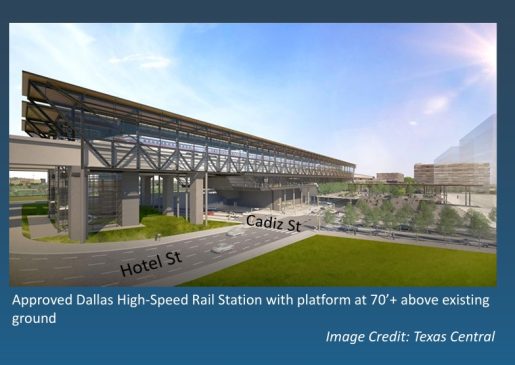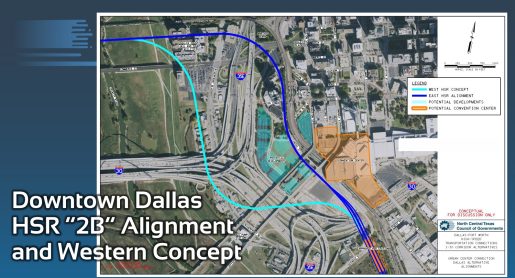Get ready for the bullet train in North Texas — it appears to be on its way, but it may not stop in downtown Dallas.
If the bullet hits its target, high-speed trains could eventually transport up to 30,000 passengers daily between Dallas and Fort Worth within 30 minutes, with a maximum speed of 250 mph.
With a price tag of $6 billion, it is no surprise that all parties involved are not in a hurry to make a mistake. With the projected employment and population growth, Dallas-Fort Worth must find ways to address transportation needs for the over eight million residents currently to almost 12 million by 2045.
The high-speed trail will hopefully lessen traffic congestion, delays, and road-related fatalities. The DFW High-Speed Update for Spring noted that “there has not been a fatality-free day on Texas roadways since November 7, 2000,” per the North Central Texas Council of Governments (NCTCOG).
The Backstory
The high-speed rail, known as a “bullet train,” has been in the works for years. In 2020, the North Central Texas Council of Governments initiated the DFW High-Speed Transportation Connections Study.
The study is in its second phase, with the ultimate aim “to evaluate high-speed transportation between Dallas and Fort Worth, with a goal of connecting to other proposed high-performance passenger systems in the state and enhancing the Dallas-Fort Worth regional transportation system,” per the NCTCOG.
In Phase 1 of the project, different high-speed transportation options were assessed, such as routes and various high-speed technologies, to improve commuting between Dallas, Arlington, and Fort Worth.
In September 2023, The Dallas Express reported that Phase 2 of the transportation study would occur over the next 18 months. This phase includes analyzing possible routes and vehicles, creating operational/service plans, completing initial engineering, and assembling environmental documentation.
Moving forward to August of this year, the Regional Transportation Council of the North Central Texas Council of Governments allocated an additional $1.6 million to expedite an alternative route to bypass downtown Dallas, veering west of downtown, through the federal review process.
The decision to find a route that bypassed downtown Dallas was propelled by the Dallas City Council’s July resolution opposing the previously favored route. City officials expressed apprehension that the prior route could encroach upon the proposed $3 billion convention center and other high-value development initiatives in the vicinity of Reunion Tower, reported The Dallas Morning News.
As such, plans are moving forward with an engineering and environmental review to vet an alternative Dallas-to-Fort Worth route that does not run through downtown Dallas. However, the newly proposed route comes with concerns.
Addressing Concerns
The proposed alternate route is to be constructed beside South Riverfront Boulevard and over a parking lot across from the Dallas County jail and courthouse. The route would intersect the Jefferson Boulevard and Houston Street viaducts and a portion of I-30 before connecting to a seven-story-tall station in the Cedars area.
Adopting this alternative route would mean losing crucial connections, such as those to Union Station and convention center hotels. Furthermore, it could potentially cut off the 31-mile rail line from the convention center, a concern for Dallas officials, reported DMN.
In addition to losing connections, the new route adds a hefty delay to the project, reported Mass Transit.
According to Michael Morris, the transportation director of the North Central Texas Council of Governments, proceeding with a different configuration for a proposed $6 billion high-speed train from Dallas to Fort Worth that includes a western route around downtown may extend the environmental review phase of the project by an additional year.
However, Morris seems to be okay with the delay if it pushes the project forward, saying in July that “It is better to get into a potential delay and not have a fatal flaw than to pursue a more expedient path and potentially have a fatal flaw in a Dallas resolution that doesn’t change,” per Mass Transit.
Dallas Assistant City Manager Dev Rastogi addressed these concerns in an August 5 memo, noting that “there was a request that the City of Dallas formally ask the NCTCOG to include the provision of direct connection from the high speed rail station to the City’s Kay Bailey Hutchison Convention Center as part of the RTC’s Dallas to Fort Worth high-speed rail alignment work. Pursuant to that request, Interim City Manager Kimberly Bizor Tolbert will send communication to Mr. Michael Morris, Director of Transportation for the NCTCOG, requesting this important connectivity be included as part of the RTC’s high-speed rail study.”
On September 9, NCTCOG held its most recent transportation meeting, a hybrid public meeting at its Arlington location and virtually.
The Dallas-Fort Worth High-Speed Transportation Connections Study provided an update during the meeting. An NCTCOG press release noted that in response to the City of Dallas’ concerns, “the Regional Transportation Council (RTC) held a workshop on July 11. On Aug. 8, the RTC decided to proceed with the federal environmental review process, incorporating flexibility to explore alternative routes for downtown Dallas that address stakeholder concerns.”
September 9, 2024, Meeting Recap
Brendon Wheeler, NCTCOG’s program manager for Transportation Planning – Metropolitan Transportation Plan, began his presentation by saying, “We are in the fifth year of this study” on high-speed transportation between Dallas and Fort Worth.
“At this point, we’re still very much in the planning stages… Fort Worth-to-Dallas connecting to the Dallas-to-Houston line really provides a backbone and opportunities for high-speed rail advancement throughout the state,” said Wheeler.
Concept: One-Seat Ride
Wheeler described the idea of a “one-seat ride,” which encompasses not having to change trains to reach your destination and provides a “seamless, connected system.”
The one-seat ride construct includes one seat/one ticket on the high-speed train connecting travelers between Fort Worth, Arlington, Dallas, and Houston via Texas Central’s Dallas passenger station.
Benefits: Safety, Reliability, and Convenience
“This is not rail as you know it,” said Wheeler, explaining that high-speed rail has “dedicated corridors just for these vehicles,” the structures are designed so that they are separated from the vehicle and other rail traffic or freight lines.
The high-speed rail originated in Japan, and they have not had a single fatality in its 60-year history, Wheeler explained, saying, “I don’t know that any other mode can say that.”
“The corridor being planned between Fort Worth and Dallas would be a fully dedicated, grade-separated facility providing the benefits of safety that this mode offers, as well as reliability, where you’re not having to intermingle with freight traffic or other commuter rail traffic that could slow it down or cause a train to miss its schedule, and the comfort and convenience that offers… you know when you book a train ticket you, know exactly when you will arrive,” offering reliability, explained Wheeler.
“Our roadway corridors are not reliable, and they will become increasingly less reliable as well our airports and other modes” as the population continues to grow, added Wheeler.
Stations’ Development Opportunities: A Three-Station Concept
High-speed rail stations offer “improvement to access to the development around it” and “more premium service than we’ve seen for passenger rail around the U.S. until today,” said Wheeler.
Wheeler added that stations often have residential and office towers connected to the station, offering continued development opportunities.
“High-speed rail in itself really needs to be brought to the downtown centers,” stressed Wheeler.
As such, Wheeler stressed that, due to Dallas-Fort Worth’s size, a three-station concept is being evaluated: “one in downtown Fort Worth, one in downtown Dallas, and one in the Arlington entertainment district area.”
Are We There Yet?
Wheeler explained that we are currently in the second segment of Phase 2, which includes the preliminary engineering and environmental documentation.
The environmental documentation assessment began in March and continues to examine factors such as “the effects of a proposed project on neighborhoods, parks, schools, air quality, noise, water systems, cultural resources, and more,” per the presentation.
TxDOT is conducting a research study on IH 30 from IH 35W in Fort Worth to Cooper Street in Arlington. The study aims to obtain environmental and federal approval by the end of 2027.
Regarding the Dallas station, Wheeler commented that “the City of Dallas and Texas Central were the ones who decided where this station would go – the only involvement from the Regional Transportation Council was to wish the station to be close to the downtown because that’s where we feel high-speed rail is of the most benefit, providing people access to the major central business district of a community.”
Current renderings of the Dallas high-speed rail station show platforms at “about 70 feet off the ground,” said Wheeler.
The Dallas station depiction is “directly south of downtown Dallas in the Cedars neighborhood… almost overhanging I30… pointed in a northwest direction,” said Wheeler.

As a result of the August Regional Transportation Council meeting, staff has been directed to “continue advancing engineering for the western alternative in downtown Dallas, as well as advancing stakeholder coordination,” said Wheeler.
Wheeler stressed that the alternative proposed route is “not as refined as the downtown Dallas option was, so there needs to be a lot more engineering feasibility work as well as stakeholder coordination to understand the pros and cons, the tradeoffs of various alternatives… that process is ongoing.”

Additional Takeaways
“This will be well over a hundred-year investment – we want to be sure we are investing in the right technology,” said Wheeler, noting that high-speed rail is the ticket.
“Since 2020, we have held over 300 meetings throughout the region,” said Rebekah Gongora, NCTCOG’s program manager under Public Involvement-Government Relations, and public meeting documents can be found here.
High-speed rail infrastructure could be in a trench, elevated, or tunnel, depending on the section.
The Dallas Express will continue to keep citizens up to date as this story unfolds.


